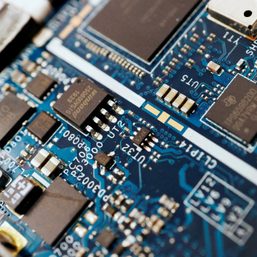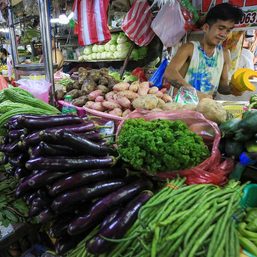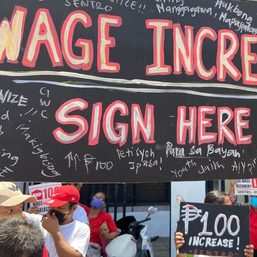SUMMARY
This is AI generated summarization, which may have errors. For context, always refer to the full article.

MANILA, Philippines – The Bangko Sentral ng Pilipinas (BSP) announced an off-cycle interest rate hike on Thursday, October 26, stepping up its battle against inflation. But what does this mean, and how does this affect you?
The rate being hiked here is the BSP’s key policy rate, which is technically called the overnight reverse repurchase facility. This figure is the central bank’s main tool in signaling its stance toward the economy.
Because Thursday’s rate hike didn’t come during a scheduled meeting, it’s called off-cycle. This off-cycle rate hike is significant because prior to it, the central bank had maintained its key policy rate at 6.25% since March 2023 as inflation began decelerating.
But after inflation picked up its pace again for the second straight month in September, the BSP decided to already raise rates, instead of waiting for its upcoming November 16 monetary policy meeting.
“The Monetary Board recognized the need for this urgent monetary action to prevent supply-side price pressures from inducing additional second-round effects and from further dislodging inflation expectations,” BSP Governor Eli Remolona Jr. said on Thursday.
How does the BSP’s rate relate to inflation?
The key policy rate affects the interest rate that banks charge to consumers – in other words, the interest that you’ll have to pay on your loans with the bank.
Theoretically, increasing interest rates could control inflation by discouraging consumers and businesses from borrowing and spending, which could then bring down prices of goods and services.
“Rate hikes are designed to slow economic growth by making loans more expensive. A policy rate increase would make it more difficult to access financing, which could lead to slower business expansion and job creation. This is by design,” ING Bank Manila senior economist Nicholas Mapa told Rappler.
However, raising the BSP’s rates won’t immediately have an impact on inflation because the higher rates will still be working their way through banking loan channels. This means the effects on inflation and the economy can take between 9 and 12 months to manifest.
In the meantime, the “urgent monetary action” that the BSP took by raising rates is its way of signaling that it is trying to manage inflation expectations seriously. Inflation expectations simply refer to what consumers and analysts expect future inflation will be.
“If we all think inflation will be high in the future – for example, next year – this may result in behavior that will simply reinforce the increase in prices even further,” Mapa said.
In fact, BSP Governor Remolona admitted that the central bank might not have looked closely enough at expectations from consumers and businesses.
According to the central bank’s Consumer Expectations Survey, about 92% of consumers and firms think that in the next 12 months, inflation will still be above 4%, which Remolona described as “worrisome.”
Why? If the general expectation is that prices will still be high, then businesses might start raising prices now in anticipation of higher inflation next year, which only reinforces and causes inflation to go up.
“This can snowball into prices spiraling out of control and is one reason why BSP can opt to hike in a ‘show of force’ to indicate it will do all it can – given its limited powers – to fight off inflation, even at the expense of growth,” Mapa said.
That’s why to quell the anxiety around prices moving higher, the BSP is hiking rates – even if it causes “collateral damage” to economic growth.
Managing inflation expectations could then help the BSP steer the economy toward a stable 2024 inflation path. With the rate hike, the central bank expects headline inflation to return to around 3% beyond July 2024. The government’s target range for inflation is 2% to 4%.
How will this affect you?
For consumers, the BSP rate hike will mean that they’ll have to pay higher interest on their loans. Credit, in general, will also be more difficult and expensive to come by.
Consumer loans – housing loans, personal loans, and auto loans – are generally priced based on the BSP’s key policy rate, meaning that consumers will be immediately faced with more expensive loans.
However, that will also depend on whether your loans are on a fixed-rate or variable-rate basis as only loans with variable-rate financing will be affected by the hikes. Your existing amortizations on your loan will be higher, which will also whittle down your purchasing power and hurt consumer consumption in the economy.
Meanwhile, credit card loans are priced based on a separate interest rate cap, which the BSP has maintained at 3% a month. This cap will be in force for at least the next six months from August 2023, or until February 2024.
How will this affect the economy?
The economy is expected to slow down as businesses and consumers rethink funding their activities using loans that are now more expensive.
“The negative impact of rate hikes on bank lending will result in less investment activity in the economy, which will result in lower productivity and slower GDP (gross domestic product) growth,” Mapa told Rappler.
So why would the BSP want higher interest rates if these only hurt consumers and economic growth? Security Bank chief economist Dan Roces said the central bank is “considering the longer-term outlook and the risks.”
“Monetary policy operates with a lag. As such, [raising rates now] will be sort of preemptive, recognizing that the benefits will outweigh the costs to the economy,” Roces told Rappler.
And according to the BSP, the aggressive tightening that it is imposing isn’t the reason behind any slowdown in economic growth.
“The tightening, as far as we can tell, has not really affected growth prospects. GDP growth slowing down is because of pent-up demand waning,” the central bank governor said.
“But we’re watching that very closely. We don’t want tight monetary policy to affect negatively our growth prospects.”
Are rate hikes the best tool against inflation?
Earlier in October, National Economic and Development Authority Secretary Arsenio Balisacan warned that further interest rate hikes “will hurt the economy, will hurt consumers, will hurt producers.”
Balisacan disagreed with the central bank’s decision to continue to raise interest rates, which he said would have “long-term effects.”
“If I were on the Monetary Board, I would say no because we have been the most aggressive in our region in raising interest rates,” Balisacan told reporters on October 6.
Although he said the economy could withstand more rate hikes if needed, he said that doing so would put the economy even further away from its peers in the region.
“That’s not something we can be proud of, because that’s increasing the cost of production, depressing consumer demand,” he added.
Economists have noted that the BSP’s tools – in this case, its rate hikes – may not be the most effective way to solve the current inflation situation. That’s because inflation right now is being largely driven by supply-side factors, like expensive rice and oil products.
“We also know very well that the source of the inflation is supply-side. It’s not the demand-side that requires monetary solution,” Balisacan told reporters.
Security Bank’s Roces also noted that monetary policy actions like rate hikes “may not be as effective when inflation is supply-side driven.”
Rate hikes can only impact inflation by alleviating demand-side pressures, so a policy rate hike may not necessarily bring prices of oil and rice down immediately, ING Bank’s Mapa said.
But as far as the BSP is concerned, monetary policy tightening is really the only action that it can use to temper inflation.
“Monetary policy cannot control supply-side price shocks, but it can serve to break the link between those supply-side shocks and expectations, and also the link between those supply-side shocks and second round effects – including, for example, transportation fare hikes and minimum wage increases,” BSP Governor Remolona said on Thursday.
“So that’s what we worry about. That’s what we focus on.” – Rappler.com
1 comment
How does this make you feel?


![[In This Economy] Too much hand-waving in the economic charter change debates](https://www.rappler.com/tachyon/2024/03/TL-hand-waving-charter-change-mar-1-2024.jpg?resize=257%2C257&crop=270px%2C0px%2C720px%2C720px)
![[Edgewise] Love me legal tenderly](https://www.rappler.com/tachyon/2024/02/tl-love-me-legal-tenderly.jpg?resize=257%2C257&crop=278px%2C0px%2C720px%2C720px)

An appreciation to the Bangko Sentral ng Pilipinas under the leadership of BSP Governor Remolona for doing “the only action that it can use to temper inflation.”